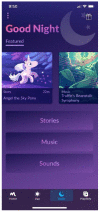Out Like a Light: Feasibility and Acceptability Study of an Audio-Based Sleep Aide for Improving Parent-Child Sleep Health
- PMID: 35954773
- PMCID: PMC9368592
- DOI: 10.3390/ijerph19159416
Out Like a Light: Feasibility and Acceptability Study of an Audio-Based Sleep Aide for Improving Parent-Child Sleep Health
Abstract
Our study examines the acceptability and feasibility of Moshi, an audio-based mobile application, among children 3-8 years old using a parent-child dyadic approach. Our 10-day within-subject pre-post study design consisted of five nights of a normal bedtime routine and a subsequent five nights exposed to one story on the Moshi application during the intervention. Each five-night period spanned three weeknights and two weekend nights. The Short-Form Children's Sleep Habits Questionnaire (SF-CSHQ) was used to measure children's sleep at baseline and post-intervention. The PROMIS, Epworth Sleepiness Scale and Pittsburgh Sleep Quality Index were used to assess parents' sleep. Among the 25 child-parent dyads, the mean child age was 4 (SD = 1.23) and 63% were male (n = 15). Mean parent age was 35 (SD = 5.83), 84% were female (n = 21), and 48.0% were Black (n = 12). For child-only comparisons, mean post-SF-CSHQ measures were lower compared to baseline. A trend in parent sleep is reported. This study shows the potential of an audio-based mobile sleep aid to improve sleep health in a racially diverse parent and child dyad sample.
Keywords: audio story; child; family; m-health; sleep.
Conflict of interest statement
Moshi Sleep was blinded and had no impact on the design, analysis, and interpretation of study results, nor do they have any knowledge of the results of the study. Although, A.S. is currently on the Board of Directors for Moshi Sleep, he was not at the time of the study and was not responsible for any data collection or analysis, therefore his role on the board did not influence the findings of the study. A.S. was not in the process of being recruited for the study while it was being conducted.
Figures
Similar articles
-
Impact of pediatric epilepsy on sleep patterns and behaviors in children and parents.Epilepsia. 2012 Jul;53(7):1162-9. doi: 10.1111/j.1528-1167.2012.03515.x. Epub 2012 May 17. Epilepsia. 2012. PMID: 22594377
-
A routine within a routine: Can bedtime yoga improve sleep for the whole family?J Bodyw Mov Ther. 2024 Oct;40:1724-1731. doi: 10.1016/j.jbmt.2024.09.007. Epub 2024 Oct 5. J Bodyw Mov Ther. 2024. PMID: 39593515 Clinical Trial.
-
Children's Sleep Habits Questionnaire in Two Subpopulations from Cape Verde and Mozambique: Exploratory and Regression Analysis.Acta Med Port. 2019 Oct 1;32(10):628-634. doi: 10.20344/amp.11841. Acta Med Port. 2019. PMID: 31625874
-
Modified Children's sleep habits questionnaire for behavioral sleep problems: A validation study.Sleep Health. 2017 Jun;3(3):136-141. doi: 10.1016/j.sleh.2017.03.009. Epub 2017 Apr 8. Sleep Health. 2017. PMID: 28526249 Free PMC article.
-
Actigraphy-measured sleep concordance, night-wakings, intraindividual sleep variability in parents and their children-Associations with childhood sleep disturbances.J Sleep Res. 2023 Jun;32(3):e13773. doi: 10.1111/jsr.13773. Epub 2022 Nov 7. J Sleep Res. 2023. PMID: 36345126
Cited by
-
Bringing Health Care Equity to Diverse and Underserved Populations in Sleep Medicine and Research Through a Digital Health Equity Framework.Sleep Med Clin. 2023 Sep;18(3):255-267. doi: 10.1016/j.jsmc.2023.05.009. Epub 2023 Jun 6. Sleep Med Clin. 2023. PMID: 37532367 Free PMC article. Review.
-
Promoting sleep and mental well-being in children: Protocol for a naturalistic pilot in-app study among users of the Aumio app.PLoS One. 2025 Apr 29;20(4):e0322302. doi: 10.1371/journal.pone.0322302. eCollection 2025. PLoS One. 2025. PMID: 40299941 Free PMC article.
-
Sleep experiences of parents of children 18 years or younger with sickle cell disease during the COVID-19 pandemic: a qualitative study.J Clin Sleep Med. 2024 May 1;20(5):777-782. doi: 10.5664/jcsm.11004. J Clin Sleep Med. 2024. PMID: 38174872 Free PMC article.
References
-
- Carter K.A., Hathaway N.E., Lettieri C.F. Common sleep disorders in children. Am. Fam. Physician. 2014;89:368–377. - PubMed
-
- Owens J.A. In: Behavioral Sleep Problems in Children. Wilkie L., editor. UptoDate; Waltham, MA, USA: 2020.
-
- Paruthi S., Brooks L.J., D’Ambrosio C., Hall W., Kotagal S., Lloyd R.M., Malow B.A., Maski K., Nichols C., Quan S.F., et al. Recommended Amount of Sleep for Pediatric Populations: A Consensus Statement of the American Academy of Sleep Medicine. J. Clin. Sleep Med. 2016;12:785–786. doi: 10.5664/jcsm.5866. - DOI - PMC - PubMed
Publication types
MeSH terms
Grants and funding
LinkOut - more resources
Full Text Sources
Medical



